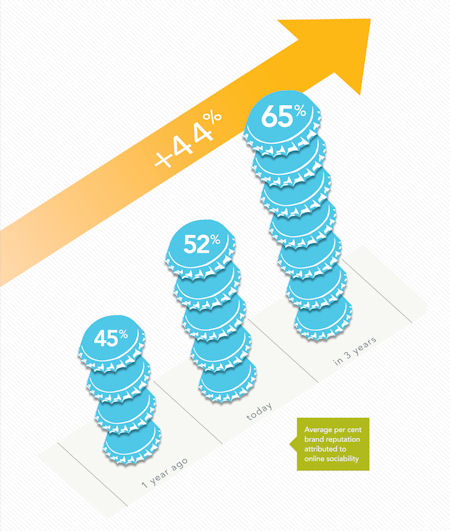If you want to be a world-class brand, you need to have a strong brand identity on social media. According to recent research on how brands use digital media (by PR firm Weber Shandwick, in partnership with research company Forbes Insights), having the right social media brand strategy is vital for a truly powerful global brand.
The research uses the term “sociability” to describe how brands are using social media to communicate well with their target audiences. It identifies how global brand leaders believe that sociability is growing rapidly as a way to enhance a brand’s overall reputation, from 52 per cent today to a projected estimate of 65 per cent in three years’ time. However, the vast majority of respondents (84 per cent) say they do not believe their own brands sociability is of world-class standard, despite the fact that they nearly all (87 per cent) have a social media brand strategy.
Average per cent brand reputation attributed to online sociability

Source: Weber Shandwick and Forbes Insight, Socialising Your Brand: A Brand's Guide to Sociability
Nine drivers of creating a sociable brand are identified by the report. These include creating original content; using particularly social ways of communicating (for example being more likely to have a branded YouTube channel); integrating across all social and traditional media channels; having a dedicated social media strategist; and reacting to what fans recommend on social media sites.
The 9 Realities of Brand Sociability

Source: Weber Shandwick and Forbes Insight, Socialising Your Brand: A Brand's Guide to Sociability
Identifying what makes some businesses more successful at being sociable, Chris Perry, president of digital communications at Weber Shandwick, says that it is important to not just talk the talk, but to make sure the whole organisation is committed to a clear social media strategy: “Organisations need to break down silos, operate strategically and integrate all marketing communications. Only then can a brand successfully and seamlessly engage in a real social dialogue.”
Parry concludes that the good news is that brands are aware of the importance of social media. The next step is using it properly: “Collectively, brands are redefining marketing models for a super-social media environment. Whether it’s to reach employees, customers or media, social communications is a powerful, unstoppable market force. Communications and marketing executives are now well aware. The question is how to use this power to maximum advantage.”
Methodology
Weber Shandwick partnered with Forbes Insights to identify what makes brands social, and how. The research was conducted via an online survey in Spring 2011 of 1,897 senior executives from high-revenue companies across 50 countries in North America, Europe, Africa, the Middle East, Asia Pacific and Latin America. Executive respondents were selected for their personal involvement in marketing, communications or public relations strategy and utilisation of digital channels as part of that strategy.
PR Masterclass: The Intersection of PR and GEO
Join PRmoment for a Masterclass featuring 10 of the industry’s foremost experts. You will walk away with a clear, actionable strategy for adapting your content to an AI-first search environment.
Taking place on Wednesday 25th February in London, both virtual and in person tickets are available.
Early bird ticket sale ends Friday 9 January.
PR MasterclassIf you enjoyed this article, sign up for free to our twice weekly editorial alert.
We have six email alerts in total - covering ESG, internal comms, PR jobs and events. Enter your email address below to find out more:









